
There’s legal risk in just about everything these days. No matter what type of company you start, you’ll need to watch your steps. This is doubly true for blue-collar entrepreneurs. The more risk involved in a company, the more likely you’ll face a lawsuit at some point. Make sure to cover all your bases to protect your business.
Register Your Business as an LLC
To secure your business, start by structuring your company as a limited liability company (LLC). This structure can help you minimize your legal responsibility and liability down the road. In fact, Investopedia defines an LLC as, “a corporate structure whereby the members of the company cannot be held personally liable for the company’s debts or liabilities.”
Assess Your Risk
From financial risks to employee health code violations, to workers’ compensation claims, every company has some chance that it takes on over the course of its life. The idea, though, is that you should attempt to minimize your risk and keep your known risk contained as much as possible. To do this, you should complete a risk survey.
You may want to contact an outside company to do a risk assessment for you. Depending on your business, you’ll need to plan for accidents, missteps and financial downturns along the way.
Create a Quality Assurance Plan
Once you’ve taken stock of the possible risk affecting your company, you’ll want to create a plan to mitigate this risk and to ensure all products produced or serviced within your facility are of sound quality.
A quality assurance plan can help ensure that all products leaving the facility are ready for public use and consumption. You don’t want your units to be recalled due to health concerns or quality issues.
Show your employees exactly what the products should look like under this plan. You should also designate a quality assurance inspector to verify all products receive a thorough inspection before they are sent off to the general public.
Train Your Employees
The next step in the process is fully training your employees. You should teach quality assurance best practices, but you also need to ensure they’re prepared in every other aspect of their jobs as well.
The more training employees have, the more likely they’ll be able to perform their jobs safely. Some of the training measures you can take to ensure a safe workplace include:
- Equipment safety training
- Assigning quality control tasks
- Creating cleaning and inspection schedules
- Scheduling policy and procedure training
The more policies and procedures you have in place, the more likely you’ll survive any liability case.
Start a Paper Trail
Make sure you document everything that goes on in your company. You want a lengthy paper trail of your activities to prove that you were not at fault should any cases suddenly arise against you. Some of the activities you’ll want to document along the way include:
- Employee training schedules
- Equipment maintenance
- Compliance training
- Cleaning schedules
- Employee performance reviews
The more carefully you record everything that goes on in your company, the less likely you’ll be considered at fault when something goes wrong.
